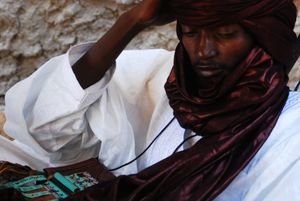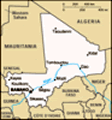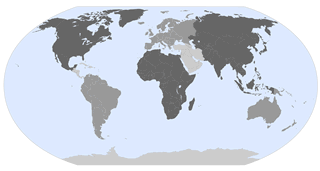Advertisement
Published: January 10th 2008

 TIMBUKTU
TIMBUKTU
MOHAMMED, A TUAREG TRADERFrom Sevare we drove on 4WD trucks to take us to Timbuktu, 7 hours it took for yus to get there an hour on paved road then the dirt tracks started, quite bumpy, I got bruises on my legs as I was seated at the very back and the space is cramped. There was a lot of checkpoints quite annoying but the drivers are used to it and did not mind it,we got to a point where we need to cross the river to get accross the road to Timbuktu, as soon as we gotto the other side the roads got better again tree lined tarmac next to the river quite pleasant ride until we got to the town where it was hot and dusty. We quickly settled in in the house that was rented for us to sleep in, we were supposed to sleep only on the roof but the living room was quite more inviting and comfortable so most of us set our mats and sleeping bags,the owner was not happy the next day to see us all sprawled in her living room but too late, she had us turned off the fridge but we turn it back on

 TIMBUKTU
TIMBUKTU
TRADITIONAL TEA PREPwhen she left! Anyway most of the time the day we arrived was spent finding a money changer quite a task as the banks are not willing to change money so we looked for some merchant traders in the central market and after some arguing, the guide we have in Timbuktu finally convinced some Tuareg or Arab merchants to change Euros but not Dollars so we had to find another who will, the dollar rate here is crap a lesson for menext timeI come visit West Africa again. That night we ate out at a place called Amanar owned by a local living in California,the people here by the way are mixed,blacks, Songhi, Tuaregs, i think the Caucasian looking people are the Songhis but cant be sure, anyway they seem to get along very well with each other. Good foodand ambience but the chicken I ordered was too tough, Chrissy announced she got accepted to Oxford so she bought everyone a round of beer, some of the girls bought jewellery from vendors milling in the restaurant. Most of us went back to the house and had a good night sleep.
The next day was a lazy day we walked

 TIMBUKTU
TIMBUKTU
ABOARD THE FERRYto the roundabout to have a photoofthe sign that says Timbuktu then had a walk around visiting some streets where the library is etc, we met Issa from lastnight a Tuareg trader he took us to the house they were rentingwhen in Timbuktu to sell their wares,oneof the guys told us a brief history oftheir trading culture while preparing tea for us,he said they study three major thingsto be a merchant, first is to read the stars for navigating, second is learning to read the sand dunes, and third what camels eat in the desert. They lounge around during the day and drink lts of water and travel at night, they traverse through vast areas of the Sahara criss crossing countries, Morocco, Algeria, Niger, Mauritania, Mali using the old ancinet caravan routesnot going through borders they dont carry passports sothey try to avoid the cities when in Morocco as they were cracking dwn on them. I managed to purchase a nice Tuareg made bracelet and was trying to buy off Issa's Tuareg sandals as the stores are closed due to Tabaski festival and weleave early the next day, his offer was too steep so I let him keep it. While

 TIMBUKTU
TIMBUKTU
WALKING TO TOWNthere at the tent having tea with them we got served some goat innards,they were grilled and quite delicious,then we set off back to the house to cool down for a bit. That night we went out for a traditional meal a number of us were not feeling well so did not eat,I had 2 1/2 servings as I was starving, the food wasquite tasty. Went back home the next morning we leave at 6am.
Left early so we can catch the ferry,same bad roads,morebruises for me. The truck designated for sick people stopped a number of times so we have to wait for them but we eventually made it to Bandiagara after about 9 hours. We are all starving by then. We had to prapare our thingsquickly for the next days trek to the Dogon country. The next morning we were dropped off by the truck to Djiguibombo where we started our trek it was a leisurely about 6 kms walk, we stopped for couple hours for lunch, the food was terrififc in my opinion. In the afternoon when it has cooled down we walked towards the escarpment, every village we goto the kids run after us and
tag along as well as annoying touts trying to sell us thing sand asking for bon bon. The houses on top of the escarpment was impressive and we had a good look then went back down to the village to spend the night the name of the town is Teli, we slept on rooftops again basking in the light of the full moon, lots of noises that night, apart from the annoying donkey howl the music is playing from somewhere apparently the last night of Tabaski,some of us partake to the dance celebration and had a good time. Next day was about 10 kms of walikg,quite hot we passed through 2 villages,one specializes in mud cloths the town is Ende and the other in carved woods things. W set off after a long siesta after lunch and ended upin the Escarpment village of Begnimato to spend the night again in rooftops.The village is dividedinto 3 sections, Christians, Animists and Moslems, Isaac our guide showed us around the villages, 8more kmsof walk and we finished in the village of Dourou where we gotpicked up bythe truck. 2 hour driveand we are backin Bandiagara for X mas, that night we celebrated Mark's

 TIMBUKTU
TIMBUKTU
ISSA, ONE OF THE TUAREG TRADERSB day which falls on the 25th, we got drunk and bit rowdy the German lady came and chastised us for disturbing her sleep, well it was x mas after all so I dont understand her problem if you stay in a camp site expect people to celebrate a holiday with some party. Oh Mark decided later on to track down some donkeys in the field, Zoe and Jen and Danielle was with him, all Jo and I can see were flashes of lights from the camera, and some laughter, Annabelle as drunk as she were managed to clean up our mess and lock the truck, we safely put her to bed. Next morning we took turns roasting the pig turning it every ten minutes, we had games, andgot drunk a lot again, oh that is after a hearty breakfast that Di prepared for us. Was along day andcantremember most of it really so the highlight was secret santa gift exhanging with Santa(John) handing out gifts. Raphael our Brazilian biker friend and the Italian Enyo joined us in the celebrations.
The next morning got ready for our journey to Burkina Faso,we camped somewhere for the night,there was a village

 TIMBUKTU
TIMBUKTU
GROUP WITH CAMELloony going around the camp chanting something, handing us a paper with writing in it,could be a spell foralli know, he was showing some karate moves to Dave at one time, he was creepy but did not harm anyone. Next morning we crossedinto Burkina Faso.
WIKIPEDIA INFO:
TIMBUKTU:
Timbuktu (Archaic English: Timbuctoo; Koyra Chiini: Tumbutu; French: Tombouctou) is a city in Tombouctou Region, in the West African nation of Mali. It is home to the prestigious Sankore University and other madrasas, and was an intellectual and spiritual capital and centre for the propagation of Islam throughout Africa in the 15th and 16th centuries. Its three great mosques, Djingareyber, Sankore and Sidi Yahya, recall Timbuktu's golden age. Although continuously restored, these monuments are today under threat from desertification.
Timbuktu is populated by Songhay, Tuareg, Fulani, and Mandé people, and is about 15 km north of the Niger River. It is also at the intersection of an east-west and a north-south Trans-Saharan trade across the Sahara to Araouane. It was important historically (and still is today) as an entrepot for rock-salt from Taoudenni.
Its geographical setting made it a natural meeting point for nearby African populations

 TIMBUKTU
TIMBUKTU
GROUP AT A TUAREG TENTand nomadic Berber and Arab peoples from the north. Its long history as a trading outpost that linked west Africa with Berber, Arab, and Jewish traders throughout north Africa, and thereby indirectly with traders from Europe, has given it a fabled status, and in the West it was for long a metaphor for exotic, distant lands: "from here to Timbuktu."
Timbuktu's long-lasting contribution to Islamic and world civilization is scholarshiBy the fourteenth century, important books were written and copied in Timbuktu, establishing the city as the centre of a significant written tradition in Africa.
DOGON COUNTRY:
The principal Dogon area is bisected by the Bandiagara Escarpment, a sandstone cliff of up to 500m (1,640 ft) high, stretching for about 150km (almost 100 miles). To the southeast of the cliff, the sandy Séno-Gondo Plains are found, and northwest of the cliff are the Bandiagara Highlands. The current population is at least 450,000. Historically, Dogon villages have frequently fallen victim to Islamic slave raiders.Neighboring Islamic tribal groups acted as slave merchants,as the growth of cities increased the demand for slaves across the region of West Africa. The historical pattern has included murder of indignenous males by Islamic
jihadists and enslavement of women and children. As early as the 12th century AD the Dogon people fled west to avoid conversion to Islam and enslavement.
At the end of the eighteenth century, the jihads that were triggered by the resurgence of Islam caused slaves to be sought for warfare. Dogon insecurity in the face of these historical pressures caused them to locate their villages in defensible positions along the walls of the escarpment. The other factor influencing their choice of settlement location is water. Nearby is the Niger and in the sandstone rock, a rivulet runs at the foot of the cliff at the lowest point of the area during the wet season.
BANDIAGARA:
Bandiagara is a city in the Malian "Dogon Country." Pronounced /Ban'yə'gar'ə/, the name translates roughly to "large eating bowl" -- referring to the communal bowl meals are served in.
Bandiagara is east south east of Mopti, some 63 km east of the Sévaré crossroads. It is home to several distinct, cohabiting ethnic groups, the Fulas, Dogons, Bambaras, Malinké. Administratively it is part of the Mopti Region.
Advertisement
Tot: 0.075s; Tpl: 0.012s; cc: 10; qc: 32; dbt: 0.0497s; 1; m:domysql w:travelblog (10.17.0.13); sld: 1;
; mem: 1.1mb























